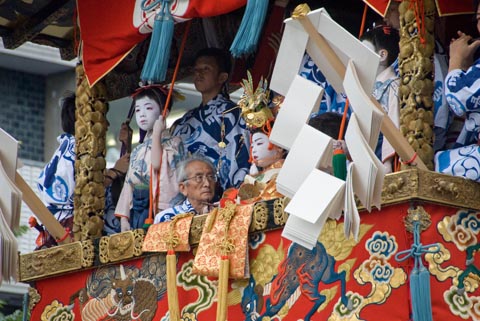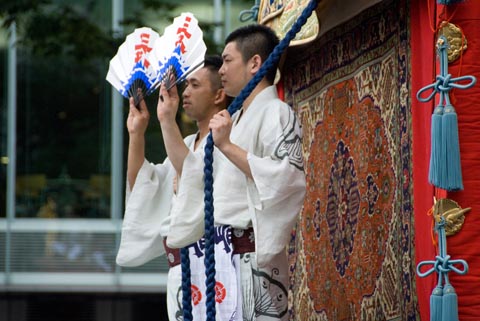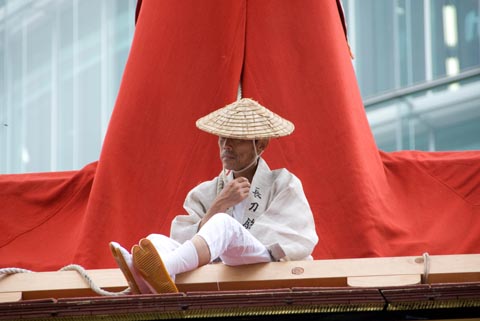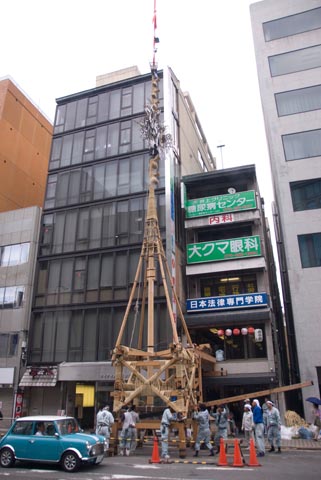We took the opportunity on a long weekend to go to Kyoto to see the Gion Matsuri. The Gion Matsuri is ranked as one of the top three beautiful festivals in Japan, as well as one of the three biggest and the most famous. Wow! The big parade of floats takes place on July 17th every year.
On the three nights before the parade is the yoiyama. The floats are displayed in the streets. Festival goers can buy chimaki, each float’s talisman for good fortune, and even go aboard some of the floats. Local homes display their silks and antiques. And along the streets are rows upon rows of stalls selling all sorts of food, drinks, and sweets.
As we came up out of the train station, we were struck with this sight: scores of people filling the street. Pretty much every cross street from Shijo to Oike and Karasuma to Kawaramachi was equally as packed. That’s a lot of people!
Musicians in the floats performed court music. We heard the song throughout the weekend, and whenever I hear that sound, “kon-chiki-chin,” I think, “Oh, Gion Matsuri.”
I don’t eat takoyaki at festivals in Gunma: too big, too doughy, not so good. But takoyaki is a specialty in the Kansai area, especially in nearby Osaka, so we had to get some. We tried this guy’s takoyaki and they were fantastic: crisp on the outside, chewy on the inside, and insanely hot. After that, we had some kara-age, yakitori, and warabi mochi for dessert.
At the end of the night, these guys are here to make sure you clear out of the street so that they can open it back up to traffic.
The next day, it was parade time. Don’t be a dummy like me and wear your yukata. Yukatas are for the Yoiyama the night before. Just wear your normal clothes to the parade. We arrived at the intersection of Shijo and Karasuma, but the crowd was so dense, so we found a less crowded spot on Oike dori closer to the end of the parade route. The parade moves slowly because it takes a long time for the floats to turn each corner, but eventually it arrived. First came the people.
Next came the floats. This is the first float, which carries the sacred child, or Ochigo, of the parade.
A closer view.
Here you can see the Ochigosan (seated and wearing the golden crown).
The gentlemen with the fans ride on the front of the floats and help signal the men pulling the float when it’s time to turn it.
Several people ride on the roofs of the floats to keep the tall spire on top from running into power lines, street signs, and other obstructions.
That’s a big wheel! The axles don’t turn, so the direction of the float is adjusted by the men who walk alongside with the wooden paddles.
This was one of my favorite floats. The praying mantis would move its arms and tilt its head from side to side.
Then it would flutter its iridescent wings!
One of the most popular sights of the festival is when the floats have to turn the corners on the parade route. Since the axles don’t turn, the men pulling the float place wet slats of bamboo under the wheels and then work together to drag the 12 ton monsters around the corner. One member of the pulling team would also run over with a gift of chimaki for the guys on the corner managing security and keeping the water buckets full.
The men on the float with the fans help signal everyone else when it’s time to heave. You can see the bamboo slats beneath the wheels.
The next day we saw one of the floats being disassembled. It was really neat to see how it was put together on the inside.
See more of our photos from Yoiyama and the parade on Alex’s photoblog.
Learn more about Gion Matsuri: Wikipedia, Mirahouse, and Gion Matsuri Volunteers.

























